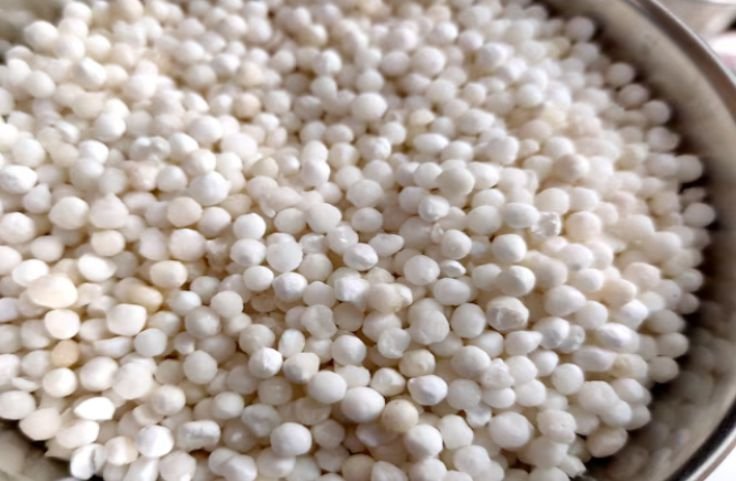Small tapioca pearls, also known as diminutive tapioca or mini boba, are a popular ingredient derived from the starch of cassava root.
When you work with small tapioca pearls, you’ll notice how they bring an interesting texture to your dishes.
Their delicate size lets them cook quickly and blend beautifully into puddings, desserts, and drinks.
You can enjoy their chewy bite without waiting too long in the kitchen.
These pearls have found their way into many Asian-inspired recipes and modern bubble teas, adding that satisfying texture you can’t miss.
Their growing demand across global cuisines shows how adaptable they are in both sweet and savory creations.
If you enjoy experimenting with new ingredients, these pearls give you a chance to create something simple yet satisfying.
They transform everyday recipes into delightful treats that keep your taste buds curious and engaged.
Table of Contents
- What Are Small Tapioca Pearls?
- What Sets Small Tapioca Pearls Apart?
- Best Uses for Small Tapioca Pearls
- Cooking Tips for Small Tapioca Pearls
- Common Mistakes to Avoid
- Storage and Shelf Life
- Where to Buy and How to Identify Them
- Nutritional Profile of Small Tapioca Pearls
- Conclusion
- Frequently Asked Questions
What Are Small Tapioca Pearls?
Small tapioca pearls are tiny, round starch balls made from cassava root. They cook quickly and develop a chewy texture that blends well in desserts, puddings, and bubble tea.
Their smaller size allows them to absorb flavors more evenly, making them a popular choice for recipes that call for smooth consistency and an enjoyable bite.
What Sets Small Tapioca Pearls Apart?
If you enjoy making puddings or bubble tea, small tapioca pearls give you more control and creativity in your kitchen.
Their texture, quick cooking time, and adaptability make them a favorite ingredient for many home cooks and chefs.
Texture and Mouthfeel: Soft Yet Chewy
When you cook small tapioca pearls, you’ll notice how they turn soft yet hold a gentle chew.
This texture blends smoothly into desserts, beverages, and soups, giving every spoonful a satisfying bite.
Their tender feel suits recipes where you want smoothness instead of the heavier texture found in larger pearls.
Cooking Time: Quick and Convenient
You don’t have to wait long to enjoy your recipe when using small tapioca pearls.
They usually cook within 5 to 10 minutes, depending on the brand.
Their short cooking time saves energy and helps you achieve that chewy texture faster without losing quality or flavor.
Preparation Methods: Soak or Direct Cook
How you prepare small tapioca pearls depends on the brand you choose.
Some require soaking for better results, while others can be boiled directly.
Following the package instructions ensures the pearls stay round, glossy, and perfectly chewy once cooked.
Appearance and Culinary Appeal: Clear and Inviting
As they cook, small tapioca pearls turn translucent and plump, adding an appealing look to your dish.
Their clear, glossy surface enhances desserts and drinks, giving them an attractive finish that invites you to take a bite or sip immediately.
Related Posts
Tapioca Pearls Recipes Beyond Bubble Tea
How to Make the Indian Comforting Tapioca Sabudana
Easy Way to Make Tapioca Bubble Tea
Best Uses for Small Tapioca Pearls
When you cook with small tapioca pearls, you open up countless ways to make your meals and desserts more interesting.
Their quick cooking time and smooth texture make them perfect for both sweet and savory recipes.
Tapioca Pudding: A Comfort Dessert
You can use small tapioca pearls to prepare classic tapioca pudding, where they absorb milk and sweetener to form a creamy texture.
Their chewiness gives the pudding a satisfying bite while blending smoothly with the sweetness.
This dish shows how small tapioca pearls turn simple ingredients into a comforting and flavorful dessert you’ll love.
Baby and Elderly Meals: Gentle and Easy to Digest
Small tapioca pearls are soft and easy to digest, making them suitable for babies and elderly individuals.
You can mix them into purees, porridge, or soups to add mild carbohydrates.
Their tender texture supports smooth digestion and helps create nourishing meals that are pleasant to eat and easy on the stomach.
Soups and Savory Dishes: Thick and Flavorful
When added to soups or stews, small tapioca pearls create a thicker consistency while soaking up the flavor of the broth.
They fit well in Asian-inspired dishes and add body without overpowering other ingredients.
Their mild taste lets them complement spices, vegetables, and coconut milk beautifully.
Coconut Desserts: Creamy and Satisfying
Pairing small tapioca pearls with coconut milk creates luscious desserts that highlight texture and flavor.
You can enjoy them warm or chilled, as they hold their shape while soaking in sweetness.
These creamy coconut-based treats are common in Asian cuisines and offer a refreshing finish to any meal.
Cooking Tips for Small Tapioca Pearls
Cooking small tapioca pearls is simple once you understand the right steps.
With the correct water ratio, heat control, and timing, you can achieve pearls that stay chewy, clear, and delicious.
Water Ratio
Use 1 cup of small tapioca pearls with 8 cups of water. The extra space helps each pearl cook evenly without sticking together.
Bring the water to a full boil before adding the pearls so they begin cooking right away and expand properly for the best texture.
Stirring
After pouring the pearls into boiling water, stir them gently. This prevents clumping and allows heat to circulate evenly.
You’ll notice them turning from opaque to slightly translucent as they cook.
A few light stirs at the start go a long way in achieving a smooth texture.
Simmering
Once the pearls begin to soften, reduce the heat to medium and let them simmer.
Cooking usually takes 15 to 30 minutes, depending on the brand.
Check occasionally for doneness; they should feel chewy yet tender.
Overcooking will make them mushy, so timing is key.
Rinsing
When the pearls reach the perfect chew, drain and rinse them under cold running water.
This stops the cooking process and removes excess starch.
The rinse also keeps them from sticking, making them ready for use in puddings, bubble tea, or any dessert of your choice.
Common Mistakes to Avoid
Cooking with small tapioca pearls can be rewarding, but a few mistakes can affect your results.
Paying attention to timing, texture, and recipe choice helps you achieve the perfect chewy consistency every time.
Overcooking
When you cook small tapioca pearls for too long, they lose their chewy texture and become mushy.
Watch them closely and taste as they cook to find the right balance.
They should feel soft but still springy when bitten.
Following the recommended cooking time helps prevent them from turning into a sticky mass.
Undercooking
Undercooked pearls can have hard centers that feel unpleasant in puddings or drinks.
Make sure they cook all the way through until they look translucent and feel chewy.
Keeping the temperature steady and testing their texture ensures even cooking and the right consistency.
Using the Wrong Pearl Type
Avoid swapping small tapioca pearls for large ones in recipes. Each type cooks differently and gives a distinct texture.
Small pearls cook faster and need less liquid and time.
Using the right size for your recipe keeps the dish balanced and the texture exactly as intended.
Storage and Shelf Life
To keep small tapioca pearls fresh, store the dry pearls in an airtight glass or plastic container and place them in a cool, dry area away from sunlight and heat.
This prevents moisture buildup and clumping.
Unopened pearls can last up to two years, while opened ones are best used within six months.
Cooked tapioca pearls, however, have a short shelf life and should be eaten within four to six hours for the best texture.
If you need to store them, refrigerate them in an airtight container for up to three days.
To reheat, place them in warm water or steam gently to restore chewiness. Avoid microwaving, as it can alter their texture.
Proper storage and reheating keep small tapioca pearls flavorful, chewy, and ready for your next recipe.
Where to Buy and How to Identify Them
If you want to cook with small tapioca pearls, knowing where to find them and how to recognize them saves time and effort.
These tiny spheres go by different names in various regions, so understanding their labels helps you get the right product for your recipes.
Local Stores: Check Asian Grocery Shops
Asian grocery stores are often the best place to find small tapioca pearls. Look in sections for baking or dessert ingredients.
Check the packaging for labels like small pearls, mini tapioca, sago, or sabudana.
This ensures you pick the right size for puddings, bubble tea, and other dishes.
Online Shopping: Convenience and Reviews
Many online retailers offer small tapioca pearls in different sizes.
Specialty baking and Asian cuisine websites provide detailed descriptions, helping you select the right product.
Reading customer reviews lets you verify quality and reliability before buying, making online shopping an easy and informed option.
Packaging and Labels: Look for Cooking Tips
Check the package for cooking instructions and recommended uses.
Smaller pearls cook faster than medium or large ones.
This information helps you choose the right type and plan your cooking process for the best texture and results in your recipes.
Nutritional Profile of Small Tapioca Pearls
Small tapioca pearls, made from cassava root, are mostly carbohydrates and provide about 358 calories per 100 grams when cooked.
Their starch content offers quick energy, but they contain minimal protein, fat, and dietary fiber.
Vitamins and minerals like calcium and iron are present only in small amounts, so they should be paired with nutrient-rich foods like fruits, dairy, or protein.
People with diabetes or those monitoring carbs should consume them carefully, while high-fiber diets may require limiting tapioca pearls.
They work well in desserts, puddings, and beverages, adding texture and energy without contributing significant nutrients.
Enjoying them as part of balanced meals ensures you get flavor and satisfaction while maintaining healthy dietary choices.
Understanding their nutritional profile helps you make informed decisions about when and how to include small tapioca pearls in your diet.
Conclusion
Small tapioca pearls are a versatile ingredient that enrich both sweet and savory dishes.
Their chewy texture enhances desserts like tapioca pudding and beverages such as bubble tea.
Being gluten-free, they suit dietary restrictions and can act as binding or thickening agents in recipes.
Easy to prepare through soaking or boiling, they are accessible to cooks of all skill levels.
Widely used in Asian and global cuisines, they appear in coconut-based desserts, snacks, and Brazilian tapioca pancakes.
Beyond traditional uses, small tapioca pearls can add texture to smoothies, soups, and creative dishes, encouraging culinary experimentation.
Their adaptability and simplicity make them an appealing choice for anyone looking to introduce new flavors and textures into everyday meals while exploring inventive recipes in the kitchen.
Frequently Asked Questions
What Are Small Tapioca Pearls Made Of?
Small tapioca pearls are made from cassava root starch. They cook quickly and develop a chewy texture that blends well in puddings, desserts, and bubble tea.
How Long Do Small Tapioca Pearls Take to Cook?
Small tapioca pearls usually cook within 5 to 10 minutes. Their quick cooking time allows you to enjoy a chewy texture without long preparation.
Can Small Tapioca Pearls Be Stored After Cooking?
Cooked small tapioca pearls should be eaten within four to six hours. Refrigerate leftovers in an airtight container for up to three days.
Where Can I Buy Small Tapioca Pearls?
You can find small tapioca pearls at Asian grocery stores or online. Look for labels like mini tapioca, sago, or sabudana to get the correct size.

Chimeremeze Emeh is a writer and researcher passionate about Africa’s most transformative root crop—cassava. Through his work at cassavavaluechain.com, he explores the entire cassava industry, from cultivation and processing to its diverse applications in food, health, and industrial use.
He also writes for palmoilpalm.com, where he shares his extensive experience and deep-rooted knowledge of palm oil, covering red palm oil, palm kernel oil, and refined products. His work there reflects his lifelong connection to agriculture and his commitment to promoting sustainable value chains in Africa.
Driven by curiosity and purpose, Chimeremeze aims to shed light on how cassava continues to empower communities, strengthen food systems, and link traditional farming wisdom with modern innovation.

